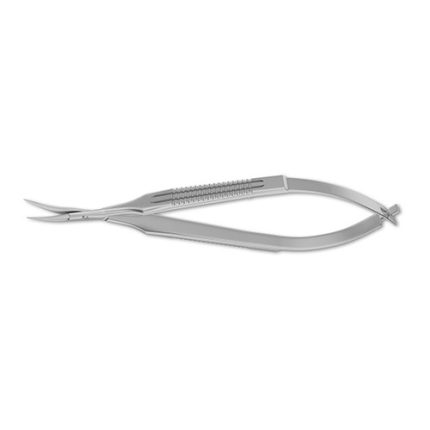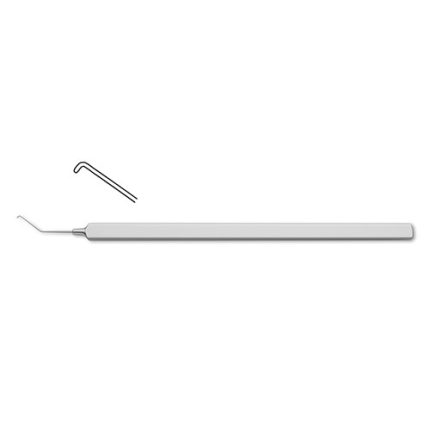Castroviejo Fixation Forceps
wide handle, w/ out platform, 1x2 teeth, 4-1/8" (10.5 cm)Castroviejo Fixation Forceps are a useful tool in a variety of ophthalmologic procedures. The toothed design aids in the grasping and handling of the conjunctiva and episcleral tissue. In addition, the forceps may be used to hold the globe in place, aiding in other surgical maneuvers. Two different tooth sizes are available on the forceps depending on surgical preference.
Castroviejo Keratoplasty & Keratectomy Scissors
Castroviejo Keratoplasty & Keratectomy Scissors Castroviejo Corneal Section Scissors are a unique tool in performing a sclerocorneal section to gain access to the anterior chamber of the eye or lens during a cataract operation. The miniature pattern of the blades delivers maximum precision for delicate cuts of the corneal tissue. Both right and left curvatures are available on the scissors to accommodate a variety of surgical preferences.
Castroviejo Keratoplasty Scissors
probe tip, lower blade 1.0 mm longer than upper blade, blunt angled blades, 4-1/4" (11.0 cm) Castroviejo Kertoplasty-Utility Scissors are a useful tool in in ophthalmologic operations. The delicate sharp tips are ideal for fine incisions of the corneal tissue for transplant. The lower blade is 1.0mm longer designed to accommodate the corneal thickness and curvature. The blunt angled blades are designed to minimize extraneous tissue damage during the procedure.
Castroviejo Lid Speculum
Castroviejo Lid Speculum is an excellent tool for visualizing the ophthalmologic surgical field. The heavyset design ensures minimal slippage once the desired spread is achieved. Curved arms contour to the orbital rim and come in three different sizes depending on surgical preference. In addition, an adjustment screw is provided to increase control during the procedure.
Castroviejo Mini Keratoplasty-Utility Scissors
wide handle, delicate sharp tips, curved, 5-1/8" (13.0 cm) Castroviejo Mini Kertoplasty-Utility Scissors are a useful tool in in ophthalmologic operations. The delicate sharp tips are ideal for fine incisions of the corneal tissue for transplant. The miniature design combined with the wide handle allows for increased control while reducing physician fatigue.
Castroviejo Needle Holder – Delicate
delicate, 10.0 mm smooth jaws, flat handle, 5.6" (14.1 cm) Castroviejo Needle Holder is a commonly used instrument in postoperative ophthalmologic procedures. The holder is commonly used for suturing corenoscleral wounds. The forceps feature delicate 10 mm tips and a locking mechanism as desired. Both straight and curved profiles are available depending on physician preference.
Castroviejo Needle Holder – Flat Handle
standard, 12.0 mm smooth jaws, flat handle, 5.6" (14.1 cm) Castroviejo Needle Holder is a commonly used instrument in postoperative ophthalmologic procedures. The holder is commonly used for suturing corenoscleral wounds. The forceps feature standard length 12 mm tips for use with a variety of suturing needles and a locking mechanism as desired. Both straight and curved profiles are available depending on physician preference.
Castroviejo Needle Holder – Heavy
heavy, 16.0 mm smooth jaws, flat handle, 5.9" (14.9 cm), straight w/ lock Castroviejo Needle Holder is a commonly used instrument in postoperative ophthalmologic procedures. The holder is commonly used for suturing corenoscleral wounds. The forceps feature heavy set 16mm tips for use with thicker suturing needles and a locking mechanism as desired. Both straight and curved profiles are available depending on physician preference.
Castroviejo Needle Holder – Round Handles
9.0 mm jaws, round handles, 4-3/4" (12.0 cm), straight w/ lock Castroviejo Needle Holder is a commonly used instrument in postoperative ophthalmologic procedures. The holder is commonly used for suturing corenoscleral wounds. The forceps feature delicate 9mm tips and a rounded handle for a more ergonomic and controlled grip. The forceps also feature a locking mechanism to free the surgeon's hands if desired.
Castroviejo Needle Holder – Very Delicate
very delicate, 9.0 mm smooth jaws, flat wide handle, 5.1" (13.0 cm) Castroviejo Needle Holder is a commonly used instrument in postoperative ophthalmologic procedures. The holder is commonly used for suturing corenoscleral wounds. The forceps feature very delicate tips and a locking mechanism as desired. Both straight and curved profiles are available depending on physician preference.
Castroviejo Scissors
curved, sharp blades, 8.0mm, 4" (10.2 cm) Castroviejo Scissors are a general purpose tool in a variety of ophthalmologic procedures. The spring action design allows for the delicate incision of tissue and is commonly used during Mohs procedures. The sharp blades allow for quick and accurate cuts with minimal extraneous damage. The curved profile of the blades allows for the contouring to the globe or periorbital surface.
Castroviejo Scissors
curved, sharp blades, 8.0mm, 4" (10.2 cm) Enucleation Scissors are ideal for excising the globe following an infection or trauma. The scissors feature a thick concave blade and a thin convex one. The thick blade allows the surgeon to push the globe anteriorly, gaining access to sever the optic nerve. The scissors are available in three different curvatures depending on surgical need.
Castroviejo Suture Forceps
w/ platform, 1x2 teeth, 4-1/4" (11.0 cm)Castroviejo Suturing Forceps are a multipurpose tool for a variety of ophthalmologic procedures. The heavy set teeth ensure the firm grasp of tissue or suturing equipment without slippage, while the slightly extended length aids in accessing difficult areas. The forceps are available with a tying platform, designed to grasp both the tissue and suturing equipment without changing instruments. Four different tooth sizes are available depending on surgical preference.
Castroviejo Suture Forceps – Angled Shaft
wide handle, 1x2 teeth on angled shaft, w/ platform, 4-1/8" (10.5 cm)Castroviejo Suturing Forceps are a multipurpose tool for a variety of ophthalmologic procedures. The heavy set teeth ensure the firm grasp of tissue or suturing equipment without slippage. The forceps are available with a tying platform, designed to grasp both the tissue and suturing equipment without changing instruments. Three different teeth sizes are available on the forceps depending on surgical preference.
Castroviejo Suture Forceps – Bayonet
wide handle, bayonet shape, 6.0 mm tying platform, 0.3 mm teeth, 4-1/8" (10.5 cm) Castroviejo Suturing Forceps are a multipurpose tool for a variety of ophthalmologic procedures. The delicate teeth are designed for the handling of fine tissue, such as corneal tissue during a keratoplasty. The forceps are available with a tying platform, designed to grasp both the tissue and suturing equipment without changing instruments. The bayonet style is ideal for difficult to reach areas and minimizes surgical obstruction during the procedure.
Castroviejo Suture Forceps – Delicate
wide handle, delicate, 1x2 teeth w/ tying platform, 4-1/4" (10.8 cm) Castroviejo Suturing Forceps are a multipurpose tool for a variety of ophthalmologic procedures. The delicate teeth are designed for the handling of fine tissue, such as corneal tissue during a keratoplasty. The forceps are available with a tying platform, designed to grasp both the tissue and suturing equipment without changing instruments. Five different teeth sizes are available depending on surgical preference.
Castroviejo Synechia Spatula
double ended, 0.5 mm x 10.0 mm & 0.5 mm x 15.0 mm blades, 5-1/2" (14.0 cm) Synechia Spatula is a frequently used tool in the treatment and management of an occulr synechia. The spatula is used to carefully dislodge the abnormal connection between the iris and either the lens or cornea. The spatula is double-ended with two different blade sizes depending on surgical preference.
Castroviejo Titanium Suture Forceps
4-1/4" (11.0 cm) Castroviejo Titanium Suturing Forceps are a multipurpose tool for a variety of ophthalmologic procedures. The heavy set teeth ensure the firm grasp of tissue or suturing equipment without slippage, while the slightly extended length aids in accessing difficult areas. The forceps are available with a tying platform, designed to grasp both the tissue and suturing equipment without changing instruments. Three different tooth sizes are available depending on surgical preference. Forceps manufactured with a lightweight, titanium alloy body offer advantages for procedures that require delicate precision. They possess greater strength and durability than stainless steel and superior resistance to corrosion, staining and pitting. Titanium forceps are almost half the weight of stainless steel, offering a more tactile feel with minimal fatigue. Finally, blue-colored tint reduces glare and the non-magnetic material resists static buildup.
Catalano Micro Tying Forceps
round handle, 6.0 mm platform w/ cross-serrations at tip, 4-1/2" (11.4 cm)Catalano Micro Tying Forceps are an ideal tool during ophthalmologic procedures and post-operative care. The micro profile along with cross serrations are ideal for gripping suturing equipment as well as delicate tissue. The extended length allows access to difficult to reach areas, while the round handle is designed to reduce physician fatigue during the procedure. The forceps are available angled or straight depending on surgeon preference.
Clayman Iol Forceps
angled 70 degrees, 3.0 mm tips, 4-3/4" (12.1 cm)Clayman IOL Folding Forceps are a unique tool used in artificial lens implantation techniques. The forceps are designed to fold the IOL either horizontally or longitudinally to allow for easier implantation. The rounded soft curve of the forceps aids in gripping the IOL with minimal damage or alteration. The angled tips provide increased visibility during the procedure.
Clayman Iris Hook
Clayman-Jaffe Lens Manipulating Hook
9.0 mm shaft w/ 0.2 mm hook, angled 45 degrees, 4-3/4" (12.0 cm)s Clayman-Jaffe Lens Manipulating Hook is a commonly used tool during cataract procedures. The hook is used to manipulate the opacified native lens during a phacoemulsification procedure. The 45 degree angled hook is ideal for moving the lens into a desired position for removal.
Cohan Needle Holder
micro, 7.0 mm jaws, round handles, curved, 4-1/8" (10.5 cm) Cohan Needle Holder is a commonly used tool in postoperative management of delicate ophthalmologic procedures. The holder features 7.0mm tips designed for handling microsutures. The spring handle with finely serrated jaws firmly grasp the needle and ensure minimal slippage. The forceps feature a locking mechanism to free the surgeon's hands if desired.
























